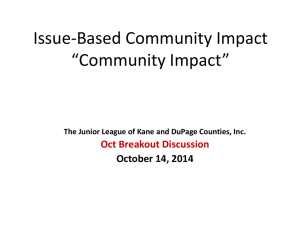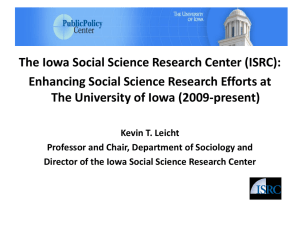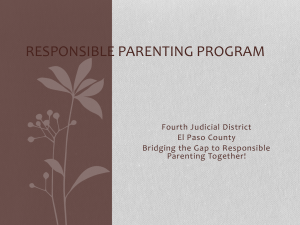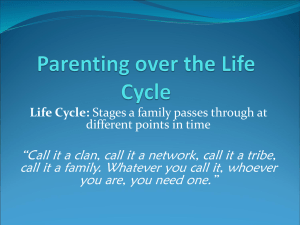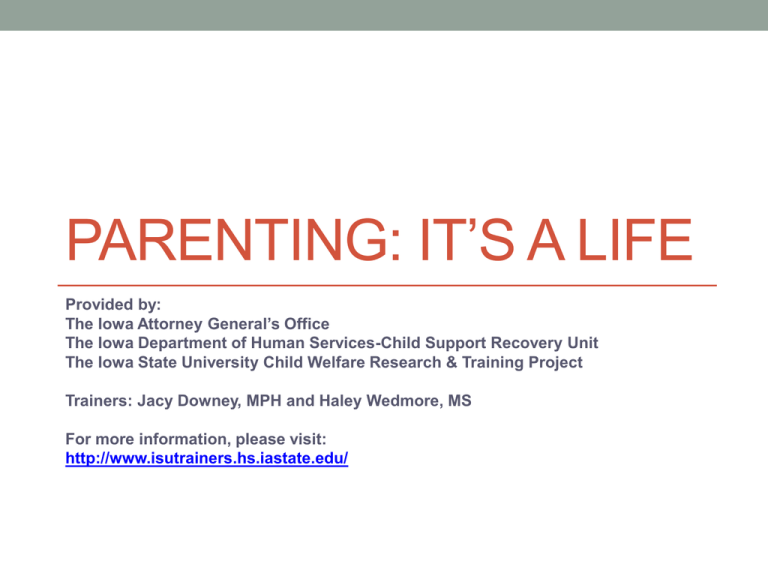
PARENTING: IT’S A LIFE
Provided by:
The Iowa Attorney General’s Office
The Iowa Department of Human Services-Child Support Recovery Unit
The Iowa State University Child Welfare Research & Training Project
Trainers: Jacy Downey, MPH and Haley Wedmore, MS
For more information, please visit:
http://www.isutrainers.hs.iastate.edu/
The Curriculum
• Designed for Grades 7-12
• Takes a neutral position
• Includes 10 modules although not entirely comprehensive. Each
module includes a variety of activities to provide experiential
learning
• Unique focus on financial aspects of teen parenting, paternity, and
child support
• Most effective when delivered in entirety, however, each module is
designed to “stand alone” and could be incorporated into a variety
of class subjects (FCS, Health, Psychology, Life Skills, etc.)
Why use this curriculum?
• Many teen parents struggle financially, academically, and emotionally
and such struggles can take a toll on the parent-child relationship
when teens do not have necessary or sufficient supports.
• Median Annual Salary for young adults (ages 24-35) in 2009:
HS dropout
HS diploma
Associate’s degree
Bachelor’s degree
Master’s degree
$21,000
$30,000
$36,000
$45,000
$60,000
• Parents who are living in poverty are more likely than their more
affluent peers to experience parental distress, depression, and mental
health disorders.
U.S. Department of Education, National Center for Education Statistics. (2011). The Condition of Education 2011 (NCES 2011–033), Indicator
17
Kessler&Cleary, 1980; Lyons-Ruth,Wolfe, Lyubchik,&Steingard, 2002; Mathiesen, Tambs, & Dalgard, 1999
• Rates of depression for low-income mothers of young children are as
high as 40% or more.
• Children of parents who are depressed or experiencing parenting stress
are at increased risk for health, behavioral, and developmental problems.
• Infants of parents with depression tend to exhibit poorer mental and
motor development, higher levels of withdrawal and irritability, and more
difficulties with emotional regulation, impulsiveness, and cooperation
than their peers who are not exposed to maternal depression.
• Parental stress also impacts the parent–child relationship by affecting
caregivers’ ability to parent in a sensitive, attuned, and developmentally
appropriate manner. They are more authoritarian, less involved, and
more negative in their interactions with their children.
• Children who experience a lack of support may feel resentment towards
the non-supportive parent and may feel neglected and betrayed.
Knitzer, 2007
Cornish et al., 2005; Downey & Coyne, 990; Sharp et al., 1995
Field, 1995
Conger et al., 2002; Evans, 2004; Jackson, Gyamfi, Brooks-Gunn,&Blake, 1998; Levy-Shiff,Dimitrovsky, Shulman,&Har-Even,1998; Linver,
Brooks-Gunn, & Kohen, 2002; McLoyd, 1990
Belsky, Woodworth, & Crnic, 1996; Bolger, DeLongis, Kessler, & Schilling, 1989; Deater-Deckard & Scarr, 1996; McBride & Mills,1994
• Iowa teen birth rate (ages 15-19) is 7.9% accounting for 3,057 babies
(2010)
• From 1991-2009 the teen (age 15-19) birth rate dropped. But, we still
have some work to do in Iowa…
Iowa: -24%
US: -37%
• Throughout the State of Iowa, single mothers and a growing number
of single fathers struggle with the complicated and serious challenge
of raising their children.
• Adding to their difficulties is the failure of non-custodial parents to
deliver their share of child support payments. This can be the mother
or the father, although is most commonly the father.
[CDC, Nat Ctr for Health Stats; VitalStats: Birth Data Files Nov 2011]
• Each year, more than 195,000 families receive assistance from the
Child Support Recovery Unit (CSRU) in collecting child support from
delinquent parents.
• But what about those families in which child support isn’t collected?
How are the children fed, clothed, insured?
• Families who do not receive child support payments often end up on
public assistance (welfare). Iowa taxpayers end up supporting the
basic needs of those children whose parents do not provide child
support.
Module 1
Teen Decision-Making
Objectives
Participants will be able to:
• openly discuss decision-making skills that affect their lives.
• compare their current lives with teen parents’ lives.
• educate others about teen pregnancy.
• list reasons for refraining from becoming teen parents.
Examples of Activities included in Module 1: Pre-Test and
Post-Test, Video of Teen Parent Interviews, Schedules.
• Show video:
http://childwelfareproject.hs.iastate.edu/parenting-its-a-life
Schedules: A Real Day in the Life of a Teen Parent
Schedule from a teen mom who has a two
month old son. Attends high school and
works part-time at a convenience store.
7:45 p.m. Pick up son from sitter
8:00 p.m. Feed son
5:00 a.m. Get up, feed son and change
8:25-9:00 p.m. Give son a bath, read him
his diaper
a book, and put him to bed
5:25-7:30 a.m. Get self ready for
school; get son ready for daycare
9:00-10 p.m. Do homework, housework,
and laundry
7:30-8:00 a.m. Take son to daycare;
get self to school
10:00 p.m. Go to bed
8:00 a.m.-3:00 p.m. Attend school
11:00-11:25 p.m. Get up to feed son,
change his diaper
3:10 p.m. Take son to a different sitter
since daycare closes at 5 p.m.
MIDNIGHT-2:00 a.m. Sleep
3:30 p.m. Go to work at convenience
store
2:00-2:25 a.m. Get up to feed son, change
his diaper, if necessary
3:30-7:30 p.m. Work at convenience
store
2:25-5:00 a.m. Sleep
Module 2
Costs of Raising Children
Objectives
Participants will be able to:
• broaden their financial thinking and assess the costs
associated with raising a child.
• understand the importance of, and implications associated
with financially supporting a child.
Examples of Activities included in Module 2: Purchases
Necessary to care for an Infant, Need or Want, Spending Bean
Game, Costs of Raising a Child
Appendix 10:
Purchases Necessary to Care for an Infant
Make a list of all items you would need to purchase if you
were expecting a newborn baby to join your household
today:
List should include things such as: clothing, bed/crib, toys,
diapers, formula, car seat, etc.
Ask students to go to a local store or visit websites to price
everything on their list.
Discuss the financial commitments involved with parenting. For
example, ask these questions:
♦ Were there any surprises about the costs of these
items?
♦ Are students able to make these purchases right now?
♦ What are students willing to give up to purchase baby
supplies?
♦ What other expenses would be incurred within a month
of bringing home a newborn (doctor’s visits, etc.)?
♦ What type of budget would be necessary to continue to
buy diapers, formula, etc.?
♦ How much do students think they would either receive
(custodial) or pay (non-custodial) in child support each
month?
♦ How much would a parent need to earn to make these
purchases or pay child support?
Ask students to compare and discuss the costs of birth control,
condoms, and abstinence with the costs of having a child.
Ask students to consider the cost of going to college and the income
range of a college-educated person. Have students compare
income earned without a high school diploma, with a high school
diploma and with a college degree. (See SLIDE 3)
Appendix 14: Need or Want?
Need
Want
Milk
Disposable diapers
Car
Telephone
Soft drinks
Washing machine
Child care
Eating out
Shoes
Cell phone
Bed
Television
Dining table
Air conditioning
Lottery tickets
computer
Video games/DVDs
Appendix 11: Anticipated Costs of Raising a Child
Estimatedannualexpenditures*on a childborn in 2010,by incomegroup,overallUnitedStates
*Estimatesare for the youngerchildin husband-wifefamilieswith two childrenandassumean averageannualinflationrateof 2.60percent.
Income Group
Year
2010
Age
Lowest
<1
Middle
Highest
$8,760
$11,950
$19,820
8,990
12,260
20,340
2011
2012
2
9,220
12,580
20,860
2013
3
9,520
12,940
21,400
2014
4
9,760
13,280
21,950
2015
5
10,020
13,620
22,520
2016
6
9,890
13,860
23,060
2017
7
10,150
14,220
23,660
2018
8
10,410
14,590
24,280
2019
9
11,590
15,950
25,990
2020
10
11,890
16,360
26,670
2021
11
12,200
16,790
27,360
2022
12
13,060
18,150
29,880
2023
13
13,400
18,620
30,660
2024
14
13,750
19,110
31,460
2025
15
14,150
20,330
34,820
2026
16
14,520
20,850
35,720
2027
17
14,900
21,400
36,650
$206,180
$286,860
$477,100
Total
www.cnpp.usda.gov/calculatorintro.htm
Module 3
What is Child Support?
Objectives
Participants will be able to:
• define vocabulary words associated with child support.
• know the difference between myths and facts associated with
child support.
• list characteristics of responsible parents.
Ex. of Activities included in Module 3: Love, Money and
Rights, Myth vs. Fact, Child Support Terms Matching,
Jeopardy.
Love, Money, Rights
♦ Love: Children need love and emotional support from
both parents.
♦ Money: Having a child is a financial commitment that
lasts to adulthood and sometimes beyond.
♦ Rights: Children have a right to family information
including their family medical history. They need access to
social security and insurance coverage and they have a
right to inheritances from both parents.
Ask students:
♦ Are you prepared to be a loving parent and to be there whenever
your child needs you?
♦ How will you financially support your child?
Scenarios…
♦ “My baby’s father and I aren’t married,
but we love each other. Do I really need
to worry about child support now?”
♦ “I don’t get along with the baby’s
mother. What happens if I refuse to pay
her child support?”
♦ “I can’t pay child support because I’m
in school and I don’t have a job.”
Child Support: Myth vs. Fact
Myth: If the father doesn’t pay support, he doesn’t have a
right to see the child. Or, if the father doesn’t want to or
can’t see his child, he doesn’t have to pay child support.
Fact: The duty to pay child support and the right to visit are
two different things. They are not connected in the law. In
the eyes of the court the child is entitled to contact with
both parents and support from both parents.
---------------------------------------------------------------------------Myth: If the father is under age 18, he can’t be declared
the father or owe a child support obligation.
Fact: A father can be required to pay child support
regardless of the father’s age.
Remember When?
Can you remember what your needs were when you were 6-years old? What did
your parent(s) or guardian provide for you? How did they support you
emotionally, physically, and financially? How did they help you survive? Use the
milestones below to write down needs at different periods of your life
(some may be in the future).
0-2 years: (Ex. My parents fed me…)
2-6 years: (Ex. They played with me and helped me learn to talk…)
6 years: (Ex. They drove me to school…)
12 years: (Ex. They helped with my homework…)
16 years: (Ex. They taught me how to drive…)
18 years: (Ex. They’ll help me pay for college…)
What types of support do you want to provide to your
children?
Module 7
Establishing Paternity
Objectives
Participants will be able to:
• define paternity.
• understand the benefits of establishing paternity.
Examples of Activities Included in Module 7: Paternity Case
Studies, Paternity Benefits
Benefits of Establishing paternity
Benefits to the mother:
♦ The right to ask for medical support for the child
♦ Knowing she isn’t the only person responsible for raising the
child
♦ The right to receive child support payments
Benefits to the father:
♦ Access to school and medical records of his child
♦ The right to ask the court for custody
♦ The right to ask the court for parenting time/visitation
Benefits to the child:
♦ Access to Social Security, military benefits, health care,
inheritance, and other financial benefits
♦ Child support payments
♦ Acknowledgement of the right to see his/her father
Module 8
Establishing a Support Order
Objectives
Participants will be able to:
• list the steps involved in the establishment of support orders.
• list the factors used to determine child support levels.
Example of Activities Included in Module 8: Child Support
Establishing/Enforcement Essays or Journal Activities
Module 9
Enforcement of Support Orders
Objectives
Participants will be able to:
• list Iowa’s child support enforcement techniques.
• give a brief description of each enforcement technique.
Examples of Activities Included in Module 9: Child Support
Enforcement Skits, Child Support Enforcement Posters.
Thank you!
• Questions? Comments? Feedback?





